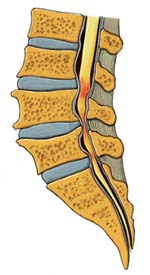More specifically, spinal stenosis is when the channels that your spinal cord and nerve roots travel through become narrower-so narrow that your spinal cord and nerve roots get squeezed. Doctors often call this squeezing “compression.” “Squeezed spinal cord and nerves” doesn’t sound pleasant, and really, spinal stenosis isn’t. It can lead to pain in your lower back, legs, neck, arms, or hands. It all depends on where in your back your spinal cord and/or nerves are getting squeezed.
Spinal stenosis can happen anywhere in your spine, but it’s most likely to happen in your low back (lumbar spine) or in your neck (cervical spine). It makes sense that if the stenosis is in your low back, it’s called lumbar spinal stenosis; if it’s in your neck, it’s cervical spinal stenosis. Spinal stenosis is quite common because changes in the spine—like this narrowing—are a natural part of growing older. Of course, that doesn’t mean that only older people will get spinal stenosis, or that everyone will get spinal stenosis as they age, but it is more common in older people.

Symptoms of spinal stenosis
Your symptoms also depend on where your spinal canal has narrowed. Generally, spinal stenosis affects your low back (lumbar spine) or your neck (cervical spine). It’s not as common to have stenosis in your mid-back (thoracic spine).
Symptoms of Lumbar Spinal Stenosis: Spinal stenosis in your low back (lumbar spine) can cause pain or cramping in your legs when you stand for long periods of time or when you walk. The discomfort usually eases if you bend forward or sit down, but comes back when you stand upright. Think of it this way: as you walk through the grocery store, does leaning forward on the grocery cart reduce your pain? Pain that eases when you bend forward is typical of lumbar spinal stenosis. This type of pain is called pseudoclaudication, false claudication, or neurogenic intermittent claudication. Other symptoms of lumbar spinal stenosis besides pain may include numbness, weakness, or tingling in the leg or foot. In severe cases of lumbar spinal stenosis, nerves to the bladder or bowel may be compressed, which can lead to partial or complete incontinence. If you’re having problems controlling your bladder or bowels, you should seek immediate medical attention.
Symptoms of Cervical Spinal Stenosis: Spinal stenosis in your neck (cervical spine) can cause pain in the neck and shoulders. It may radiate down your arm or hand. Cervical spinal stenosis can also cause headaches, numbness, or muscle weakness. It can also affect the nerves that control your balance, which can lead to clumsiness or a tendency to fall. The pain from cervical spinal stenosis may be occasional or chronic, and it can also range from mild to severe.